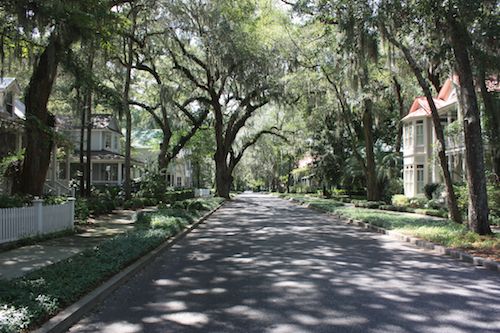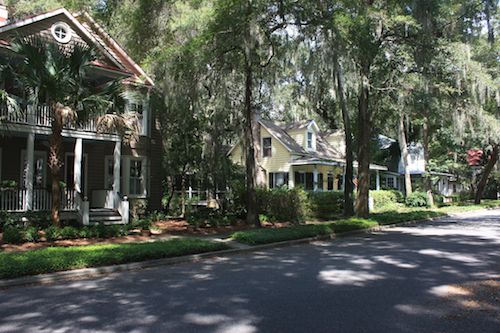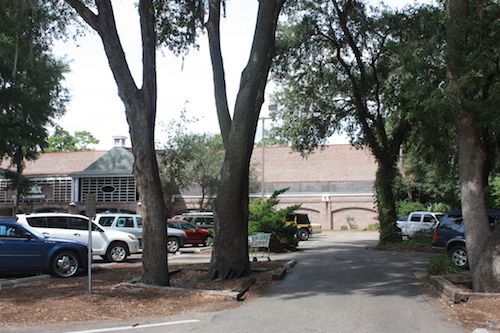Crow’s Nest: Busman’s holiday to New Urbanist development
I’ve written before about a book by Penn professor Witold Rybczynski: Last Harvest: How a Cornfield Became New Daleville (Real Estate Development in America from George Washington to the Builders of the Twenty-first Century, and Why We Live in Houses Anyway). I checked it out of the library again to use as a reference on my vacation… on a side trip to see good community design in person.
The book has a local focus on Chester County and the process of developing land in Pennsylvania even as it describes national trends and profiles a few places that embody the New Urbanism design: Seaside and Celebration in Florida and among others, Newpoint near Beaufort, South Carolina.

Since I was on holiday just a few miles from there I decided to see Newpoint for myself. From Rybcynski’s book I knew the development had begun in the 1990’s and that it was built a little at a time, with front porches, sidewalks, and back alleys for cars—a real neighborhood and not the typical sprawl we see most places today.
From Rybcinski’s book I also noticed that Charles Fraser (who developed part of Hilton Head and appears in a book by John McPhee I wrote about last month, Encounters with the Archdruid), brought a group of Walt Disney executives to see Newpoint as they began to plan for the new town of Celebration.

Newpoint’s developer, Vince Graham, used as examples for his architecture and town design the part of Beaufort across the river (appropriately, Old Point) as well as Savannah, Georgia and Charleston, South Carolina. As Rybcynski notes, if you’re trying to emulate a classic southern town you couldn’t choose better examples.
As I excitedly walked around the neighborhood snapping pictures, Denise took Owen on a stroll in the other direction. I didn’t worry about losing them—the development is a compact few blocks in size. The street signs not only tell you what the side street is, but they also repeat the name of the street you are on—and the one at right angles does the same (I’ve never seen this before; can you tell I was delighted by it?) Even the sidewalks have a plaque with the name of the streets they accompany.

One of the streets is even named Fraser; a nod to the developer who pioneered living in naturalistic landscapes?
The houses are beautiful and totally in keeping with the scale and architecture of a much older town. The houses were hard to photograph because the trees are so well established there. The grand old trees were retained in the process of building the town and so many new ones have been planted.

We met a woman walking her dog who greeted us with the friendly charm I’ve learned to associate with people from the South—but it turns out she is from Pennsylvania. She chose this neighborhood (as I suspect many do) because she was looking for a place where she would meet people on the sidewalk as she got some air and exercise—a very healthy combination.
It’s only a short walk in the development to a small park, the community open space. There are a few village-style stores in Newpoint, including a café with very good ice cream! And it’s only 1.3 miles (with sidewalks) to a grocery store—that short distance a criteria for those of us seeking to reduce our gasoline use or being car-free in retirement.
Here’s the parking lot of the local supermarket—perhaps my favorite commercial parking lot:

Why do we care about communities that embody the good design found in New Urbanism? Because they take up less space than conventional sprawl development, offering the possibility that more land can be kept in a natural state (and then enjoyed by the people who live there). Because developments that have front porches and sidewalks are nice places to live, where people gain a sense of community through regular interaction with each other. Because they may rely less on the use of the automobile, thereby saving energy and money. And because we live in communities too.
No mention of this kind of development would be complete without mentioning Randall Arendt, Vice President at Natural Lands Trust who has written several books on the subject: Rural by Design: Maintaining Small Town Character; Growing Greener: Putting Conservation into Local Plans and Ordinances; Conservation Subdivision Design; Crossroads, Hamlet, Village, Town: Design Characteristics of Traditional Neighborhoods, Old and New, and Envisioning Better Communities, among others.
There’s even a photo of Newpoint in Crossroads, Hamlet, Village, Town (page 60) and pedestrian- and environment-friendly development examples throughout.
It made my vacation especially rewarding to be able to see an example of good community design in person.
Posted by Daniel Barringer on Sepember 3, 2012.
